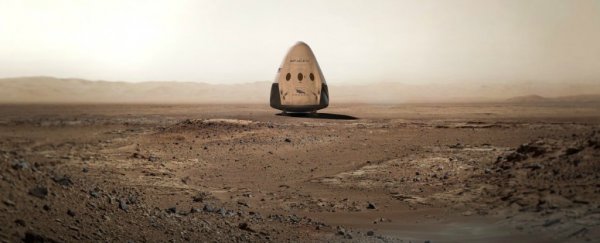On Wednesday, Elon Musk's private company SpaceX announced on Twitter that it plans to send a spacecraft to Mars as soon as 2018.
The mission - which SpaceX is calling 'Red Dragon' - will involve sending a Dragon 2 spacecraft to Mars to retrieve samples collected by NASA's Mars rover and then return them to Earth.
Here's Musk's announcement:
Dragon 2 is designed to be able to land anywhere in the solar system. Red Dragon Mars mission is the first test flight.
— Elon Musk (@elonmusk) April 27, 2016
SpaceX has had big plans to usher in a new era of reusable rockets that could send the first humans to Mars and return them home for a while. In 2011, SpaceX released a video showing how they were going to re-land a rocket booster after launching it to space - something that had never been done before. And in 2015, SpaceX began attempting to land their rockets exactly how they had envisioned in the video.
If you check out the latest photos and illustrations on SpaceX's Flickr account, you'll see something that is even cooler than landing a rocket on Earth: landing a spacecraft on Mars. And judging from the illustrations, SpaceX plans to land on Mars using a super-simple approach that has never been tried before.
This is SpaceX's Dragon spacecraft, which is not designed to carry humans, sitting on the Red Planet:
This unmanned Dragon capsule has been making trips to the International Space Station since 2010. But to get to Mars, which is 560,000 times farther, the Dragon will need to ride a more powerful rocket than the Falcon 9, which it takes to the ISS.
That rocket is SpaceX's Falcon Heavy, illustrated below, that is scheduled to launch out of Kennedy Space Centre for the first time next year.
However, this monster rocket will only take Dragon so far. Getting to Mars is easy compared to landing on it because the Martian atmosphere is a tricky beast to control.
The Martian atmosphere is about 1,000 times thinner than Earth's, so simple parachutes won't slow a vehicle down enough to land safely.
But that atmosphere is still thick enough to generate a great deal of heat from friction against a spacecraft. Therefore, to land on Mars you have to have a spacecraft with a heat shield that can withstand temperature of 1,600 degrees Fahrenheit (871 degrees Celsius).
Luckily, Dragon's heat shield can protect it against temperatures of over 3,000 degrees Fahrenheit (1,649 degrees Celsius), so plummeting toward Mars, illustrated below, shouldn't be a problem heat-wise.
But there's still the problem of slowing down. Although gravity on Mars is about one third of what it is on Earth, the vehicle is still plummeting toward the ground at over 1,000 miles per hour (1,609 kmh) after entering Mars's atmosphere. If it were to hit the ground at those speeds, you'd have a disaster.
The way that SpaceX aims to deal with this tricky problem is to use the thrusters on board the Dragon spacecraft to first redirect its momentum from downward to sideways, as illustrated below, thus reducing its speed:
And then, as the spacecraft continues to plunge toward the surface, it will fire its thrusters one final time for a soft, vertical touch down:
 SpaceX Photo on FlickrThis sort of landing is unlike anything that anyone has ever tried before, but you have to admit that Dragon looks pretty great on Mars if it ever manages to get there:
SpaceX Photo on FlickrThis sort of landing is unlike anything that anyone has ever tried before, but you have to admit that Dragon looks pretty great on Mars if it ever manages to get there:
The last major Mars landing was NASA's Curiosity rover in 2012. This landing was a huge success but extremely complicated, involving half a dozen steps that, if not completed perfectly, would end in disaster. NASA dubbed the landing process "7 minutes of terror" because that's how long it took to enter the atmosphere and land.
But the technology isn't ready for human passengers just yet.
But wouldn't recommend transporting astronauts beyond Earth-moon region. Wouldn't be fun for longer journeys. Internal volume ~size of SUV.
— Elon Musk (@elonmusk) April 27, 2016
This article was originally published by Business Insider.
More from Business Insider:




